Alban Jasper Conant
American Artist 1821-1915
Accomplishments
A triple-A polymath, Alban Jasper Conant was an artist, an archaeologist, and an anthropologist. As an artist, he painted not only members of prominent families, judges, and legislators, but also a president. His portrait of the Smiling Lincoln was Mary Todd Lincoln’s favorite.
As an archaeologist and an anthropologist, he wrote Footprints of Vanished Races in the Mississippi Valley: Being an Account of Some of the Monuments and Relics of Prehistoric Races Scattered Over Its Surface With Suggestions as to their Origin and Uses, which was published in 1879 and frequently reprinted, even as late as 2016. He was a curator of the University of Missouri and a member of the Sociétié Ethnographique of Paris and the Anthropological Society of Washington.
In addition to all these accomplishments, he played several instruments and was said to have a fine singing voice. In 1877, he wrote 11 chapters on the archaeology of Missouri for The Commonwealth of Missouri: A Centennial Record. But the accomplishment in which he took the most pride was his portrait of Abraham Lincoln, painted from life in 1860.
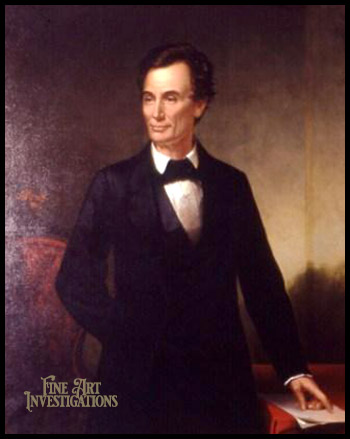
Alban Jasper Conant
Smiling Lincoln, c. 1860
Oil on Canvas, 50 x 40 inches
Southern Illinois University, Edwardsville, Illinois
In 1893 he published a book, My Acquaintance with Abraham Lincoln. He penned “A portrait painter’s reminiscences of Lincoln”, for McClure’s Magazine in March 1909 (Vol. 32, no. 5). In 1910 when he was 89, he wrote and published his final book, A Visit to Washington, DC – 1861-62.
Biography
Alban Jasper Conant was born in Chelsea, Vermont, on September 24, 1821, the son of Caleb Conant, a cabinetmaker and sign painter. His ancestors included a soldier who fought in the Battle of Bunker Hill and survived Valley Forge. But the family’s patriotism did not equate to wealth. Alban taught music in order to earn tuition to attend the National Academy of Design. There, artist Henry Inman, encouraged him.
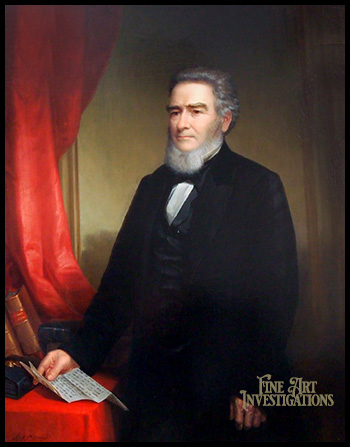
Alban Jasper Conant
Edward Bates, 1861
Oil on Canvas, 49 x 39 inches United States Department of Justice
In 1845, Conant married Sarah Mahala Howes (1822-1867). They lived in Troy, New York, in 1850, but moved to Saint Louis, Missouri in 1857, In 1860, Conant was one of the founders of the Western Academy of Art. That same year, a patron commissioned him to go to Springfield, Illinois, to paint the Republican presidential candidate, Abraham Lincoln. After the election, Conant went to Washington, DC, and portrayed members of Lincoln’s cabinet, including Attorney General Edward Bates. portraying government officials including Edward Bates and Edwin Stanton, who would be Attorney General and Secretary of War in Lincoln’s cabinet.
Sarah Conant died on October 30, 1867. In their twelve years of marriage, she bore eight children, four daughters, and four sons, but only three survived childhood. Conant, 48, remarried in 1869 in San Francisco. His bride was 22-year-old Briona Bryan. They had a son, Alban Jasper Conant, Jr., born in St. Louis in 1870. Briona died in 1875 at the age of 29.
By 1880, Conant had moved to Upper Alton, Illinois, By 1887, he was in New York City working at the famed 10th Street Studios, where he kept a studio the rest of his life. He died February 3, 1915. [1]
Conant and Abraham Lincoln
In September 1860, when Lincoln was a presidential candidate, Alban Jasper Conant (1821-1915) painted Lincoln from life. The artist described Lincoln’s face:
The line of the nose…was straight on one side and slightly curved on the other. The lower lip was fuller on the right side than on the left, as if swollen from a blow or the sting on an insect. The lines of the lower part of the face met in sharp angles on each side of the mouth. Above all, the heavy mass of black hair, which was quite long stood out [illegible] it fell over his forehead, which was fine and symmetrical. When his features were in repose his expression was sad and thoughtful. And this was intensified by the drooping of the lower eyelid, showing the white below the iris.[2]
Conant included in his portrayal one of Lincoln’s distinctive features: his swollen lower right lip. The size of the lower lip is evident in Lincoln’s life mask.
A. J. Conant also wrote:
…I had my first glimpse of him. He was standing at the other end of the room, surrounded by his friends. His face alight with interest and pleasure, smiling, genial – an astonishing contrast to the serious, homely pictures of him with which I had become familiar.
But when Conant arrived the next morning for the first sitting, “he turned from his heaped up desk and threw himself wearily into a chair, I looked at him in dismay. All the light and life had gone out of his face. It had settled into heavy, sagging lines.” Conant’s recollection of Lincoln echoed the words of a literary publisher, James Grant Wilson (1832-1914), “his grayish-brown eyes were perhaps the saddest I ever saw. However, when a good story was told, whether by himself or another, his homely face lighted up till he was positively handsome.” [3]
The painter engaged the presidential candidate in political conversation and painted The Smiling Lincoln. Conant depicted Lincoln with his head firm and straight, his cheeks smooth, his left eyebrow slightly arched, and camouflaged the mole within the color of the cheek. Conant eliminated the cleft chin and painted Lincoln’s eyes less deeply set than in life. He colored the eyes dark blue.
“…When it was finished, Mrs. Lincoln came down to have a look at it before I took it away… “Yes,” she said, “that is good. That is the way Mr. Lincoln looks among his friends.” Then she added with a little laugh, “I only hope he will look that way in November.”[4]
Throughout his life, Conant continued to paint portraits of Abraham Lincoln, just as Gilbert Stuart and Rembrandt Peale profitably painted George Washington over and over again. Conant changed his portrayal of Lincoln over the years. The first image is, if not the painting from life, is one painted near the same time. The second is adapted from a later photograph of Lincoln, possibly Alexander Gardner’s from February 1865. The third is actually a high quality print published from the original in the collection of T. B. Walker, a wealthy businessman and art connoisseur, whose collection became the Walker Art Museum in Minneapolis, Minnesota. Alexander Gardner’s iconic photograph of Lincoln may have been the basis for Walker’s painting. In the fourth, painted in 1911, Conant returned to his earliest depictions of the 16th president.

Alban Jasper Conant
Smiling Lincoln, 1860
Southern Illinois University Edwardsville, Illinois
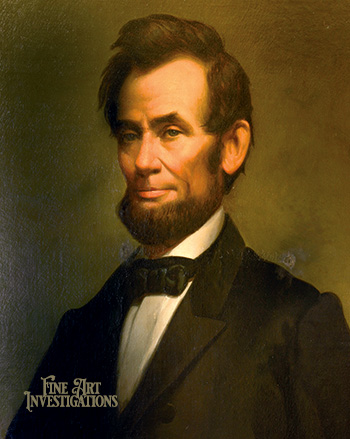
Alban Jasper Conant
Smiling Lincoln, after 1860
Southern Illinois University Edwardsville, Illinois

Alban Jasper Conant
Abraham Lincoln, after 1865
Private Collection
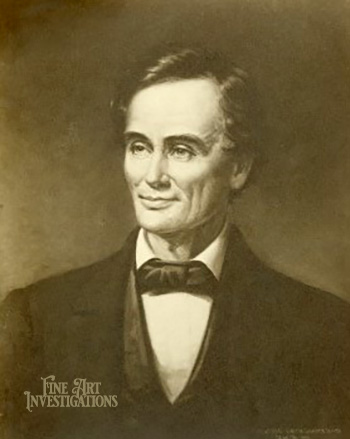
Alban Jasper Conant
Smiling Lincoln, 1911
Missouri Historical Society, St. Louis, Missouri
A. J. Conant’s Legacy
The Missouri Historical Society in Saint Louis owns over two dozen paintings by Alban Jasper Conant, including the one above Abraham Lincoln. Individuals across the nation own more still. His portraits hang at the United States Department of Justice, the Smithsonian American Art Museum, Amherst, Princeton, Colgate University, Dickinson College, the Abraham Lincoln Presidential Library, the State Supreme Court of New York, and the New York Historical Society.
Some of my personal favorites are Rev. Henry Ward Beecher at the Litchfield Historical Society, Litchfield, Connecticut, Rev. James McCosh at the Princeton University Art Museum, and Woman of Strong Character in a private collection.
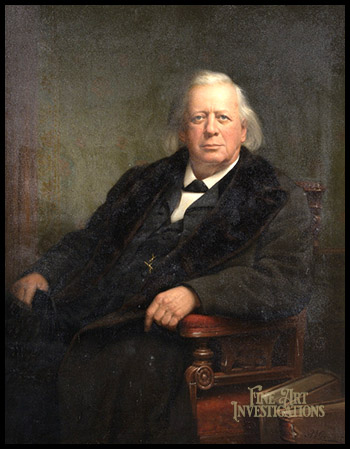
Alban Jasper Conant
Smiling Lincoln, 1860
Southern Illinois University Edwardsville, Illinois

Alban Jasper Conant
Smiling Lincoln, after 1860
Southern Illinois University Edwardsville, Illinois
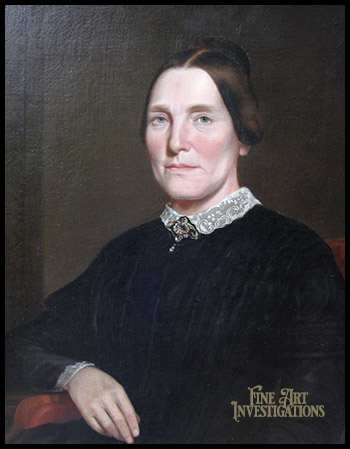
Alban Jasper Conant
Abraham Lincoln, after 1865
Private Collection
Footnotes:
1. “Howell Van Blarcom Application”, U.S. Sons of the American Revolution Membership Applications, 1889-1970, Volume 165, Application Number 32994; Joseph A. Dacus, James William Buel, A tour of St. Louis: or, The inside life of a great city, (St. Louis, Missouri: Western Publishing Company, 1878), 71-75; C R Barns; Alban Jasper Conant; William F Switzler; G C Swallow; R A Campbell; William Torrey Harris, The Commonwealth of Missouri: A Centennial Record (St. Louis, Bryan, Brand & Co., 1877), 703-706; A. J. Conant, Census of the United States, 1850, Troy Ward 3, Rensselaer, New York; Roll: M432_584; Page: 121A, lines 27-31; Household of A. J. Conant, Census of the United States, 1860, St Louis Ward 8, St Louis (Independent City), Missouri; Roll: M653_652; Page: 662, lines 10-17; Household of A. J. Conant, 1870, St Louis Ward 5, St Louis, Missouri; Roll: M593_815; Page: 139B, lines 19-27; Household of A. J. Conant, Census of the United States, 1880, Upper Alton, Madison, Illinois; Roll: 233; Family History Film: 1254233; Page: 206B, lines 20-26; Household of Alban J. Conant, Census of the United States, 1900, Manhattan, New York, New York; Roll: 1085; Page: 5B lines 54-55; Household of Amos W. Smith, Census of the United States, 1900, Bayonne Ward 4, Hudson, New Jersey; Roll: 971; Page: 27A6-13 (line 12); Household of Alban J. Conant, Census of the United States, 1910, 1910; Census Place: Manhattan Ward 15, New York, New York; Roll: T624_1031; Page: 4A, lines 48-49
2. “Painter of Lincoln and Other Great Men Works at 92,” New York Times, October 19, 1913, http://query.nytimes.com/mem/archive-free/pdf?res=F50A15FA385B13738DDDA00, 994D8415B838DF1D3, accessed summer 2012.
3. Ibid.; James Grant Wilson, “Recollections of Lincoln,” Putnam’s Magazine, Vol. 5, No. 5 (February 1909), 515.
4. “Painter of Lincoln and Other Great Men Works at 92,” New York Times, October 19, 1913, op. cit.
